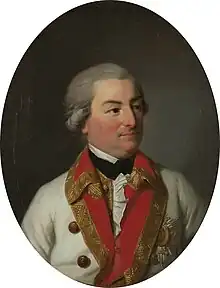| George I | |
|---|---|
 | |
| Prince of Waldeck and Pyrmont | |
| Reign | 24 September 1812 – 9 September 1813 |
| Predecessor | Friedrich Karl August |
| Successor | George II |
| Born | 6 May 1747 Arolsen, Waldeck |
| Died | 9 September 1813 (aged 66) Rhoden, Principality of Waldeck and Pyrmont |
| Spouse | Princess Augusta of Schwarzburg-Sondershausen |
| Issue | Princess Christiane Prince Karl George II, Prince of Waldeck and Pyrmont Prince Friedrich Prince Christian Princess Augusta Prince Johann Ida, Princess of Schaumburg-Lippe Prince Wolrad Princess Mathilde Prince Karl Christian Princess Karoline Prince Hermann |
| House | House of Waldeck and Pyrmont |
| Father | Karl August, Prince of Waldeck and Pyrmont |
| Mother | Countess Palatine Christiane Henriette of Zweibrücken-Birkenfeld |
George I (German: Georg Fürst zu Waldeck und Pyrmont; 6 May 1747 – 9 September 1813) was Prince of Waldeck and Pyrmont from 1812 to 1813.
Life
Born May 6, 1747. He was the son of Karl August, Prince of Waldeck and Pyrmont and Countess Palatine Christiane Henriette of Zweibrücken-Birkenfeld. Like his brother Friedrich, he was also educated in Switzerland, became a colonel in the Austrian service in 1778 and a major general in the infantry in 1783.
After he got married in 1784, he lived in Switzerland, but later moved to Rhoden, whereupon his brother ceded the county of Pyrmont to him on October 25, 1805, which he ruled independently since then as Prince of Pyrmont, being there at the same time in 1806 resided until he became Prince of Waldeck after his brother Friedrich died on September 24, 1812. He was well received by Emperor Napoleon, with whom he met in Warsaw along with his brother Friedrich.
He valued arts and sciences and founded a coin collection, which is said to be particularly outstanding for its ancient Greek coins.[1]
Prince of Waldeck and Pyrmont
The principality was divided 1805, Pyrmont was given to George, and his brother Friedrich Karl August stayed with Waldeck. In 1807, Waldeck joined the Confederation of the Rhine.
After the death of his brother in 1812, George took over the government in Waldeck.
Marriage and children

He married Princess Augusta of Schwarzburg-Sondershausen (1 February 1768 – 26 December 1849), daughter of August II, Prince of Schwarzburg-Sondershausen and Princess Christine of Anhalt-Bernburg, in Otterwisch on 12 September 1784.[2] They had nine sons and four daughters:
- Princess Christiane of Waldeck and Pyrmont (23 March 1787 – 16 March 1806)
- Prince Karl of Waldeck and Pyrmont (7 July 1788 – 3 October 1795)
- George II (20 September 1789 – 15 May 1845), married Princess Emma of Anhalt-Bernburg-Schaumburg-Hoym, had issue
- Prince Friedrich of Waldeck and Pyrmont (3 November 1790 – 1 February 1828), married Ursula Polle, created Countess of Waldeck, had issue who held the title Count/Countess von Waldeck.
- Prince Christian of Waldeck and Pyrmont (19 June 1792 – 8 July 1795)
- Princess Augusta of Waldeck and Pyrmont (7 August 1793 – 29 April 1794)
- Prince Johann of Waldeck and Pyrmont (25 September 1794 – 8 October 1814)
- Princess Ida of Waldeck and Pyrmont (26 September 1796 – 12 April 1869), married George William, Prince of Schaumburg-Lippe, had issue.
- Prince Wolrad of Waldeck and Pyrmont (23 April 1798 – 24 August 1821)
- Princess Mathilde of Waldeck and Pyrmont (10 Apr 1801 – 13 Apr 1825), married Duke Eugen of Württemberg, had issue.
- Prince Karl Christian of Waldeck and Pyrmont (12 April 1803 – 19 Jul 1846), married Countess Amalie of Lippe-Biesterfeld, had issue.
- Princess Karoline Christiane of Waldeck and Pyrmont (17 November 1804 – 3 March 1806)
- Prince Hermann of Waldeck and Pyrmont (12 October 1809 – 6 October 1876), married Countess Agnes Teleki de Szék, no issue.
Augusta survived her husband by 36 years, living as a widow in Arolsen Castle. She died on 26 December 1849 aged 81, and was buried in Rhoden at Schloss Rhoden alongside her husband.[3]
Ancestry
| Ancestors of George I, Prince of Waldeck and Pyrmont | |||||||||||||||||||||||||||||||||||||||||||||||||||||||||||||||||||||||||||||||||||||||||||||||||||||||||||||||||||||||||||||||||||||||||||||||||||||||||||||||||||||||||||||||||||||||||||||||||||||||||||||||||||||||||||||||||||||||||||||||||||||||||||||||||||||||||||||||||||||||||
|---|---|---|---|---|---|---|---|---|---|---|---|---|---|---|---|---|---|---|---|---|---|---|---|---|---|---|---|---|---|---|---|---|---|---|---|---|---|---|---|---|---|---|---|---|---|---|---|---|---|---|---|---|---|---|---|---|---|---|---|---|---|---|---|---|---|---|---|---|---|---|---|---|---|---|---|---|---|---|---|---|---|---|---|---|---|---|---|---|---|---|---|---|---|---|---|---|---|---|---|---|---|---|---|---|---|---|---|---|---|---|---|---|---|---|---|---|---|---|---|---|---|---|---|---|---|---|---|---|---|---|---|---|---|---|---|---|---|---|---|---|---|---|---|---|---|---|---|---|---|---|---|---|---|---|---|---|---|---|---|---|---|---|---|---|---|---|---|---|---|---|---|---|---|---|---|---|---|---|---|---|---|---|---|---|---|---|---|---|---|---|---|---|---|---|---|---|---|---|---|---|---|---|---|---|---|---|---|---|---|---|---|---|---|---|---|---|---|---|---|---|---|---|---|---|---|---|---|---|---|---|---|---|---|---|---|---|---|---|---|---|---|---|---|---|---|---|---|---|---|---|---|---|---|---|---|---|---|---|---|---|---|---|---|---|---|---|---|---|---|---|---|---|---|---|---|---|---|---|---|---|---|
| |||||||||||||||||||||||||||||||||||||||||||||||||||||||||||||||||||||||||||||||||||||||||||||||||||||||||||||||||||||||||||||||||||||||||||||||||||||||||||||||||||||||||||||||||||||||||||||||||||||||||||||||||||||||||||||||||||||||||||||||||||||||||||||||||||||||||||||||||||||||||
Notes and sources
- ↑ Historisch-genealogisches Handbuch über alle Grafen und Fürsten von Waldeck und Pyrmont seit 1228 (in German). Germany: Verlag von G. Klaunig. 1883. p. 80.
- ↑ C. Arnold McNaughton, The Book of Kings: A Royal Genealogy, in 3 volumes (London, U.K.: Garnstone Press, 1973), volume 1, page 232. Hereinafter cited as The Book of Kings.
- ↑ Ancestors of Queen Juliana, Jaarboek Centraal Bureau Genealogie, Den Haag
- thePeerage.com - Georg I Prinz zu Waldeck und Pyrmont
- http://www.documentarchiv.de/nzjh/1807/rheinbund_akzessionsvertrag-waldeck.html (German)
- Karl Theodor Menke: Pyrmont und seine Umgebung. Hameln, Pyrmont, 1840, S.65
- L. Curtze: Geschichte und Beschreibung des Fürstentums Waldeck. Arolsen, 1850, S.619f.